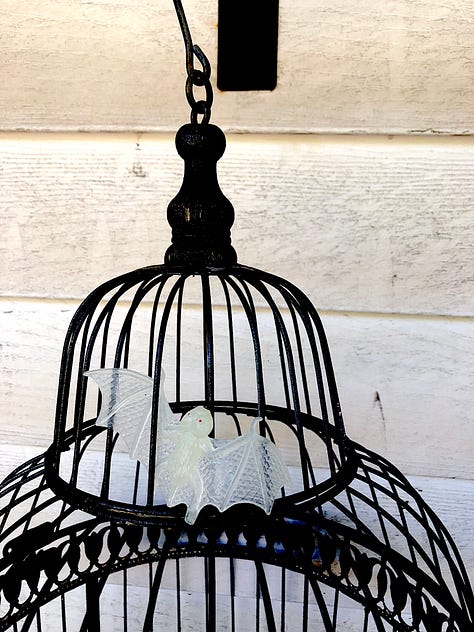Brunette Gardens at Halloween
A reminder to plant garlic and other edible perennials—plus a batty fact.

By Lisa Brunette
We’ve always planted garlic on Halloween, which makes me think there’s something coincidental about the bulb plant’s storied ability to ward off vampires. So in a bit I’ll tell you why bats hang by their feet. They’re the only mammals that do.
Some gardeners wait to plant garlic in the spring, but as it’s a bulb plant, and most other bulbs like to overwinter, that seems to best mimic the natural environment. I’ve checked with the more seasoned growers at my local farmer’s market, and they wholeheartedly concur.
Fresh from last year’s archives, below is our how-to on garlic—but not just garlic! We also plant potato onions in the fall. It’s effectively a perennial onion, as the bulb multiplies, producing many more bulbs from the main. All you do is save some to plant from your harvest each year. We’ve had four years of onions from just one bulb-starter purchase. Ya gotta love that.
The awesomeness of alliums
By Lisa Brunette So far this late summer, I’ve encouraged you to plant now for a fall crop of carrots as well as put in some asparagus, the perfect perennial for years of spears to come. This time I want to talk about alliums. There are hundreds of species in the plant genus allium, but the two I suggest embracing in your garden are g…
Speaking of perennial vegetables, another one you might think about for fall planting is asparagus, which is amazing, and I truly believe the world would be a better place if every yard contained an asparagus patch. It’s a great amount of food for very little effort, and it comes back for you reliably every year.
This fall, plant the lazy gardener's vegetable: asparagus
By Lisa Brunette Asparagus is a perennial vegetable, which means it comes back every year on its own. Once established, an asparagus bed will send up fresh, nutrient-packed shoots with very little work on your part. It's an ideal situation for the lazy gardener.
While I’m on the incredible subject of perennial food plants, I’d be remiss if I didn’t turn you onto horseradish. Anthony’s made pickled horseradish for a few years now, all harvested from the one root we planted back in fall 2018.
Horseradish, for the masses
It’s that time of year once again. Time to make the horseradish! Horseradish is ridiculously easy to make, from a recipe point of view, and only mildly difficult, from a practical stance. The ingredients are few, and the process is easy. The only thing you need to be careful of are the fumes.
We’ve switched up our horseradish game this year, however, after discovering that you can ferment it, preserving it in a salt brine instead of relying on the vinegar pickling. Fermentation gives you a more long-storing horseradish sauce, plus probiotic benefits to boot. I’ve gone kind of batty for fermentation this fall, so expect some evangelizing on that fine preservation method in the future.
I’ll get to the real bats in a minute, but first, let me wow you with my tiny, token nod toward Halloween decorating.



I don’t expect you to be impressed with my decorating prowess, but in keeping with our mission to support even the smallest, apartment-level homestead, here you can see what’s possible on a small front porch, which would also work on a balcony.
We live in a neighborhood where the residents behind us host a Halloween block party complete with massive inflatable ghouls and a kid-friendly DJ. So we’re not even trying to compete with that. We’ve lived here for six years now and haven’t had a single trick-or-treater, but we don’t take that personally because trick-or-treating seems to be going by the wayside anyway. Wah-wah…
Why do bats hang upside down?
Bats are our only truly flying mammals, and that’s no slack against flying squirrels, which don’t actually fly but glide.
The bat’s mammalian status is partly why it’s more apt to hang upside down than sit upright, as unlike many birds, bats do not possess hollow bones. From an article in Bat Conservation International:
This means that bats need to reduce weight in other ways to be able to take flight. Their long bones, like femurs, are light so they can fly, and because of this, they can’t withstand the compression standing up. In 1977, D.J. Howell and Joe Pylka published a paper in the Journal of Theoretical Biology delving into this issue. They found that most bats’ leg bones “cannot withstand compression stress,” so “hanging is advantageous.” Bats also have skin membranes that spread out between their light, elongated fingers and ankles, which is great for flying, but makes it difficult to sit or stand.
While we might view hanging from a parallel bar as a lot of work, for bats, it’s just easier, as their body composition supports it, with leg and feet tendons and ligaments built for hanging.
There’s also the practical matter. It’s easier to swing into flight from a hanging perch, as bats need only let go to escape predators on the wing.
Happy Halloween!






LOVE this post :) Your little porch is so cute. We also have a tiny garden but manage to pack things in. We just planted asparagus in a raised bed. To our joy and surprise it's coming up, (although we realise it will be at least another two years before we can consume it!) I've always planted garlic at this time of year after being taught how to do it by a very forward thinking primary teacher. As it happens, I'm just finishing a post about the wonders of fermenting the bulbs, so I see that great minds think alike :) (Note to self to try the horse radish!) Beautiful post, I thoroughly enjoyed the read x
Interesting about bats!